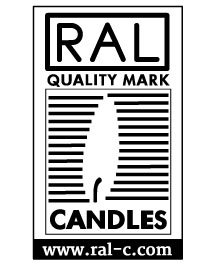Consumer Information Candles
The high-quality Munich Jewels scented candles are hand-poured and made exclusively in Germany. They are subject to the control of the Quality Association for Candles and are certified with the RAL quality mark.
RAL quality mark provides security 
This quality mark not only guarantees a safe selection of raw materials, but also the testing of all ingredients used to ensure that they are harmless to health. In addition, the wicks are tested for burning and soot is reduced to a minimum.
Proper candle care
As a dealer, we are obliged to ensure the proper handling of candles in accordance with the recommendations of the Association of German Candle Manufacturers. V., Frankfurt. Please note:
- The candle is a living light and must be cared for and constantly watched like an open fire.
- Leftover matches, pieces of wick and other foreign objects do not belong in the burning plate.
- Candles cannot tolerate drafts, which is why they start to soot.
- If the candle is visibly sooty, carefully shorten the wick while burning and extinguish it if necessary.
- If the wick burns on one side, carefully bend it to the side. Please do not bend or break the solidified wick.
- If possible, burn candles until the entire burner plate is liquid.
- Docht zum Löschen in die flüssige Wachsmasse tauchen und wieder aufrichten, damit er beim Anzünden richtig steht.
Burning time Munich Jewels scented candle
The burning time of 35 hours is an approximation! The actual burning time depends on the room temperature and, above all, the draft conditions.
Raw material used
The Munich jewels scented candles are made from high-quality parrafin. Paraffin consists of saturated, straight-chain and branched hydrocarbons (alkanes) and is predominantly obtained from the fossil raw material petroleum. During the distillation of the crude oil, various products are separated out depending on the boiling point in order to obtain the so-called paraffin sludge. They are processed and carefully cleaned using complex processes such as distillation, deoiling, filtration and hydrorefining. The paraffin qualities obtained in this way are non-toxic, white and almost odorless.
Wick
The wick is another quality feature of our scented candles. Because it is very important for the candle burning. The perfect burning of the candle largely depends on its properties.
Wicks are braided from cotton, cleaned, prepared and bleached. This serves to largely prevent afterglow when the flame is extinguished and ensures even burning with a calm flame.
FAQ – Frequently asked questions
What should you consider when lighting the candle?
Mit dem Docht muss vorsichtig umgegangen werden. Er darf nicht abbrechen. Man sollte darauf achten, dass keine Fremdkörper wie etwa Streichholzköpfe in die Brennschüssel fallen.
Why shouldn't there be any foreign objects in the burning bowl?
The foreign bodies, such as matchstick residues, pieces of wick or flies contaminate the wax, which in turn clogs the wick and negatively affects its absorbency. In addition, the foreign objects can catch fire, making the candle a source of danger.
What to do if the candle soots or flickers?
If the wick is too long, you should trim it in small pieces until the soot stops. Drafts should be avoided. If the wick bends too much to one side, it should be raised carefully.
Some wicks form knot-like enlargements at the tip of the wick when they burn. How can you remedy this?
If necessary, remove the so-called “soot flowers” or “soot fungi” or “cleaning” with wick scissors. Fallen “cleaning” contaminates the burning bowl and impairs the candle from burning properly.
Why shouldn't you extinguish candles shortly after lighting them?
If the burning time is short, the wick has not yet absorbed enough wax and then burns out all the way to the burning bowl.
What is the best way to extinguish candles?
Blow out the flame or smother it with a fire extinguisher and avoid touching the wick if possible.
What should you do if the wick continues to glow after you extinguish the candle?
Each wick naturally glows a little. If the wick actually burns out, you can either dip it into the liquid wax mass or squeeze out the embers with wet fingers.